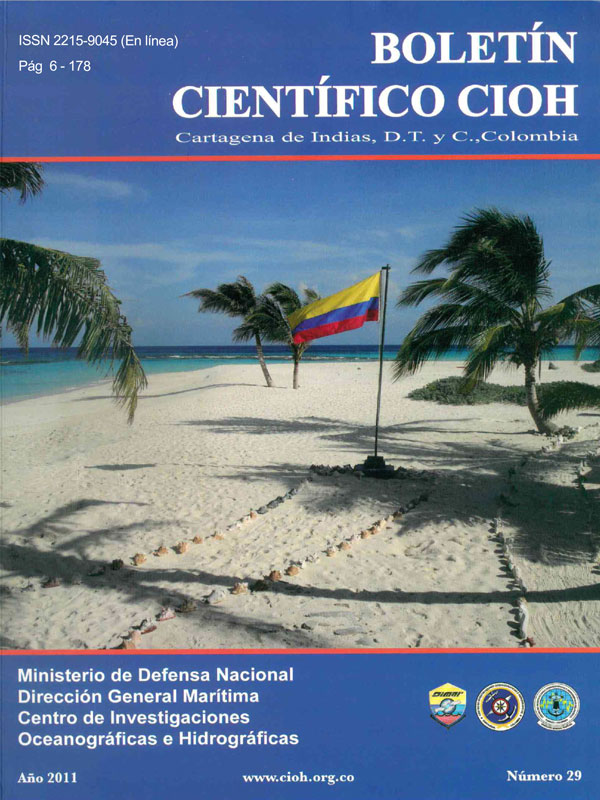Determinación de Vibrio cholerae en tanques de aguas de lastre de buques internacionales que arribaron al Terminal ultiboyas de Ecopetrol y al Puerto de Tumaco
DOI:
https://doi.org/10.26640/22159045.232Keywords:
Ballast water, ships, Vibrio cholerae, microbial contamination, salinityAbstract
One of the prominent sources of aquatic invasive species to coastal regions, are the ballast waters discharged from ships, through which invading microorganisms can reach the bay regions, producing major contamination. For this reason, samples of the ballast water from the ships in international traffic that arrived in Tumaco were taken to identify the presence of microorganisms. The survey was conducted during the period from April to October 2010, in 48 ballast water tanks from the 18 ships that arrived at the Ecopetrol Buoyage Terminal in the Bay of Tumaco. In this universe, it was determined if there were Vibrio cholerae in these water samples and at the same time, it served to determine the physical-chemical conditions of the water ballast tanks of these ships. The result was that in 12 vessels the presence of Vibrio cholerae was confirmed, which means that 67% of the ships surpass the permissible level (absence/100ml), allowed by the International Maritime Organization (IMO).Downloads
References
[2] Torres ME, Pírez MC, Schelotto F, Varela G, Parodi V, Allende F, Falconi E, Dell’Acqua L, Gaione P, Méndez MV, Ferrari AM, Montano A, Zanetta E, Acuña AM, Chiparelli H, Ingold E. Etiology of children’s diarrhea in Montevideo, Uruguay: associated patho-gens and unusual isolates. J. Clin. Micro-biol. 39: 2134-2139, 2001.
[3] Huq A., Xu B., Chowdhury M., Islam M., Montilla R, y Colwell R., A Simple Filtration Method To Remove Plankton-Associated Vibrio cholerae in Raw Water Supplies in Developing Countries. Applied and Environmental Microbiology, July 1996, p. 2508–2512 Vol. 62, No. 7.
[4] Sunny Jiang y Ajay K. Goel. Bacteria and viruses in coastal waters: implications to public health from California coast to the Bay of Bengal. Department of Civil and Environmental Engineering, University of California, Irvine, USA; Biotechnology Di-vision, Defense Research y Development Establishment, India *Corresponding Con-tact information: 1367, SE II, University of California.
[5] Centers for Disease Control and Preven-tion National Center for Environmental Health Vessel Sanitation Program Health Practices on Cruise Ships: Training for Employees Transcript.
[6] Joachimsthal, E.L. Ivanov V., Tay, J.-H. & Tay S.T.-L. Bacteriological examination of ballast water in Singapore Harbour by fl ow cytometry with FISH. En: Marine Poll Bull. 2004. 49 334 – 343p.
[7] Gollasch, S. German ballast water sampling manual. 1st International Workshop on Guidelines and Standards for Ballast Water Sampling. GloBallast Monography Series. 2003. No. 9, IMO London, 38-45 p.
[8] CCCP, Centro de Investigaciones Oceanográficas e Hidrográficas del Pacífico. Procedimiento para la toma de muestras in sito a bordo de una embarcación (Laq-PT-030). San Andrés de Tumaco. 2010-Jun-23 PP.
[9] American Public Health Association. Standards Methods for the Examination of water and wastewater, 21 ed. Washington, DC: APHA; 2005.
[10] McCarthy S., Khambaty F. 1994. International Dissemination of Epidemic Vibrio cholerae by Cargo Ship Ballast and Other Nonpotable Waters. Applied and environmental microbiology. 1994. Vol. 60. (7). 2597-2601p.
[11] Murphy, J. y Riley J. P. A modifi ed single solution method for the examination on phosphate in natural water. Anal. Chim. Acta. 1952.
[12] Strickland, J.D. y. Parsons T.R. A practical handbook of seawater analysis. Fish. Res. Board of Canada. Segunda Edición. Otawa. 1968.
[13] Bendschneider, K., Robinson, R.J. A new Spectrophotometric Method for the determination of nitrite in sea water. 1952.
[14] Bravo F. Monte L, Ramirez R, Alvarez M. Aplicación de la técnica de hibridación de colonias para la identificación de Vibrio cholerae 01 toxigénico. Rev. Cubana Med Trop. 1996. 48 (3) 169 -170.
Downloads
Published
Issue
Section
License
Attribution — You must give appropriate credit, provide a link to the license, and indicate if changes were made. You may do so in any reasonable manner, but not in any way that suggests the licensor endorses you or your use.
NonCommercial — You may not use the material for commercial purposes.
NoDerivatives — If you remix, transform, or build upon the material, you may not distribute the modified material.
No additional restrictions — You may not apply legal terms or technological measures that legally restrict others from doing anything the license permits.



